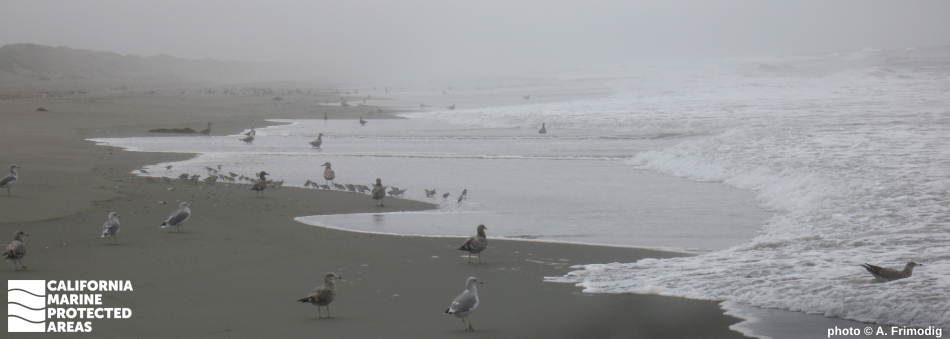
Overview
Located about three miles west of Arcata, Samoa State Marine Conservation Area (SMCA) sits in the middle of Humboldt County's coastline. Protecting more than 13 square miles, this SMCA hugs the northern end of the Samoa peninsula, a spit that separates Humboldt and Arcata bays from the Pacific Ocean. Together, these bays form the second largest estuary in California. This marine protected area (MPA) features more than four miles of shoreline, with coastal dunes and grasses rolling behind the sandy shore.
The MPA extends from its sandy beaches to depths of over 150 feet, cascading to soft, muddy and sandy seafloor lined with eelgrass and sea whips. The marine habitat supports a large variety of fishes like rockfish, lingcod, and surfperch. Anadromous fish such as Chinook salmon pass through Samoa SMCA during lifecycle migrations, heading to nearby Mad River to spawn as adults, while young fish newly acclimated to salt water exit from the river to grow to adulthood in ocean waters. Dungeness crab can be taken inside the SMCA. Those who wish to remain onshore can relish the tranquility of the solitary beach while enjoying the superb beachcombing and wildlife viewing opportunities that Samoa SMCA offers.
Regulations
It is unlawful to injure, damage, take, or possess any living, geological, or cultural marine resource, EXCEPT:
Recreational take of salmon by trolling, surf smelt by dip net or Hawaiian-type throw net, and Dungeness crab by trap, hoop net or hand is allowed. Commercial take of salmon with troll fishing gear, surf smelt by dip net, and Dungeness crab by trap is allowed. Includes take exemptions for the following tribe:
California Code of Regulations Title 14, Section 632(b)(8)(opens in new tab)
Quick Facts
MPA size: 13.06 square miles
Shoreline span: 3.6 miles
Depth range: 0 to 158 feet
Habitat composition*:
- Sand/mud: 13.01 square miles
*Habitat calculations are based on three-dimensional area and may exceed the total MPA area listed above.